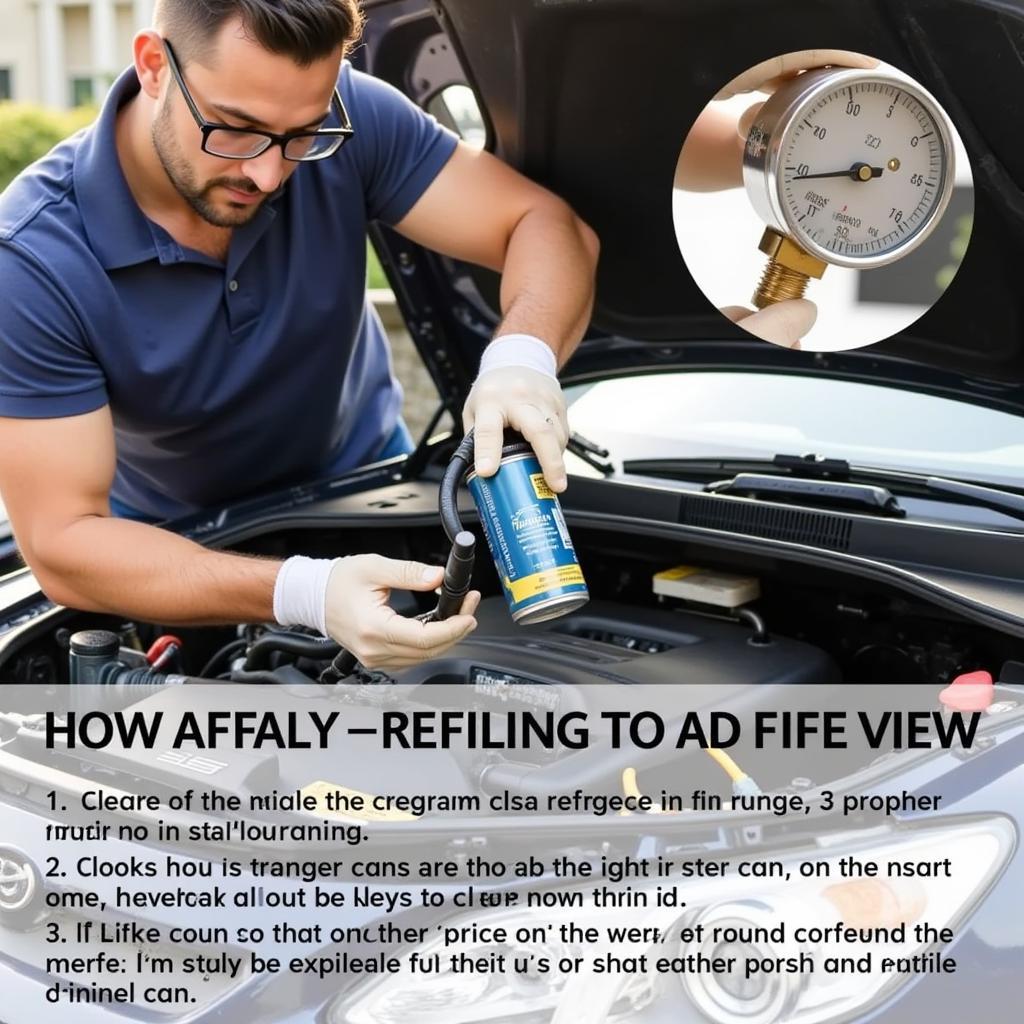Refilling your car AC system can seem daunting, but with the right knowledge and tools, it’s a task you can tackle yourself, just like Chris Fix. This guide provides a comprehensive walkthrough, covering everything from diagnosing the problem to ensuring a successful recharge.
Understanding Your Car’s AC System
Before diving into the refilling process, it’s crucial to understand the basics of how your car’s AC system works. It’s a closed system, meaning the refrigerant circulates continuously. Key components include the compressor, condenser, evaporator, and expansion valve. These components work together to cool and dehumidify the air blown into your cabin.
Common AC Problems and Their Causes
Several issues can cause your AC to underperform. Low refrigerant levels are a common culprit, often due to leaks. Other potential problems include a faulty compressor, clogged condenser, or a malfunctioning expansion valve. Diagnosing the problem correctly is the first step towards a successful repair.
How to Diagnose a Low Refrigerant Level
One way to determine if your AC system is low on refrigerant is to check the pressure using a gauge set. Connect the gauges to the low and high-pressure ports on the AC system. Observe the readings and compare them to the recommended pressure range specified in your car’s owner’s manual. Low pressure on both sides usually indicates low refrigerant.
 Checking Car AC Pressure Gauge Reading
Checking Car AC Pressure Gauge Reading
Gathering Your Supplies for Refilling Car AC System Chris Fix Style
Refilling your car’s AC system requires specific tools and materials. You’ll need a refrigerant kit designed for your car’s refrigerant type (typically R-134a or the newer R-1234yf), a gauge set, safety glasses, and gloves. Choosing the correct refrigerant is vital for system compatibility and environmental responsibility.
Choosing the Right Refrigerant for Your Car
Using the wrong refrigerant can damage your AC system and be harmful to the environment. Always consult your car’s owner’s manual or a qualified technician to determine the correct type of refrigerant for your vehicle. Purchasing a quality refrigerant kit ensures optimal performance and longevity.
 Essential Car AC Refrigerant Kit and Tools
Essential Car AC Refrigerant Kit and Tools
Refilling Your Car AC System: A Step-by-Step Guide
Once you have the necessary supplies, you can begin the refilling process. Start by connecting the refrigerant can and gauge set to the low-pressure port. Then, carefully open the valve on the refrigerant can and monitor the pressure on the gauge. Add refrigerant slowly, allowing the system to stabilize.
- Connect the refrigerant can and gauge set: Ensure a secure connection to prevent leaks.
- Open the valve on the refrigerant can: Release the refrigerant slowly and steadily.
- Monitor the pressure: Check the gauge regularly to avoid overfilling.
- Check for leaks: Inspect for any signs of leaks around the connections and components.
- Test the AC system: Run the AC and check the air temperature to ensure it’s cooling properly.
Important Safety Precautions
Remember, refrigerants are under pressure and can cause harm if mishandled. Always wear safety glasses and gloves when working with AC systems. If you’re unsure about any step, it’s best to consult a qualified technician. “Safety should always be your top priority when working with car AC systems,” advises John Miller, a seasoned automotive HVAC specialist.
 Refilling Car AC System using Gauge and Refrigerant Can
Refilling Car AC System using Gauge and Refrigerant Can
Refilling Car AC System Chris Fix: Troubleshooting Common Issues
Even with careful execution, you might encounter issues during the refilling process. If the pressure doesn’t increase, there might be a significant leak. If the AC doesn’t cool properly after refilling, other components might be faulty.
“A properly functioning AC system is not just about comfort, but also about safety, especially in extreme temperatures,” adds Sarah Chen, an automotive engineer with over 15 years of experience. “Don’t hesitate to seek professional help if you encounter any difficulties.”
Conclusion
Refilling your car AC system, guided by the principles advocated by experts like Chris Fix, can be a manageable DIY project. By understanding your car’s AC system, using the right tools and materials, and following the proper steps, you can keep your car cool and comfortable. Remember to prioritize safety and consult a professional if you encounter any challenges. For further assistance or expert advice, connect with us at AutoTipPro at +1 (641) 206-8880 or visit our office at 500 N St Mary’s St, San Antonio, TX 78205, United States.







Leave a Reply